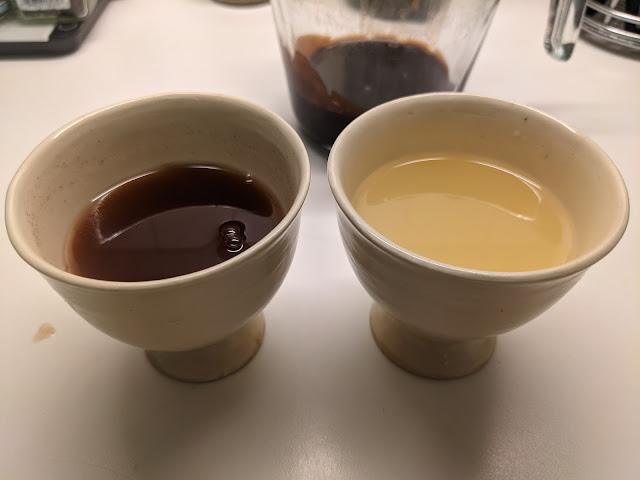Wine from the Yeast Cakes
Now that the yeast cakes are ready, and nice and dry (they firmed up quite nicely after drying), I'm ready to start making wine from them.
Qimin Yaoshu is structured around the yeast cakes, and to help keep them straight, I'm numbering them and the wines that are attached to each cake recipe. These yeast cakes are the first "exceptional" yeast cakes, so I'm calling them YE1, and below are the translated directions to make two different wines using them, a millet wine (YE1W1) and a rice wine (YE1W2).
I'm starting the process of making these now, and I'll report back once I have some more photos to show. For sizing, the recipe clearly tells us that one volume of yeast cakes is enough for 21 or 18 volumes of grain, which means something like 60 volumes of alcohol, if you figure that you get about as much liquid out as cooked grain, which is about three times the volume of the dry grain.
Since I'm making this to hopefully panel at Birka in two weeks, and complete at King and Queen's A&S the week after, I probably want at least a liter of each, maybe two. that'll also fit with the size of the bowls I'll be fermenting in.
Working backwards, 2L / 60 parts = 33mL of yeast cakes. Taking a likely looking cake...
I start grinding it, since I don't have the time to dry it in the sun, and they're already clean since I didn't make them on dirt or leave them outside. Unfortunately...
It wasn't so dry on the inside.
Oh well. I've broken it into pieces and left it to dry in a warm part of my kitchen in a cheesecloth bag. I'll see how it is tomorrow. The recipe is very clear about the yeast being dry, so I should probably aim for that.
Broken up, this cake is about 100mL, so this should be plenty for both wines if I'm aiming for two liters each.
造酒法:A method for making wine
YE1W1 (millet), YE1W2 (rice)
全餅麴,曬經五日許,日三過以炊帚刷治之,絕令使淨。
|
Take whole yeast cakes, dry them in the sun for perhaps five days, and three times a day, take a pot scrubbing brush and brush them well, making them really clean.
|
若遇好日,可三日曬。然後細剉,布帊盛,高屋廚上曬經一日,莫使風土穢污。
|
If you happen to have good weather, you can [just] dry them for three days. Then, break them into small pieces, gather them in a large cloth, and place them in a high place in the kitchen to dry for one day, not allowing wind-borne dirt to soil it.
|
乃平量麴一斗,臼中擣令碎。若浸麴一斗,與五升水。浸麴三日,如魚眼湯沸,酘米。
|
Take one level dou of the crushed yeast cakes, and grind them into a fine powder in a mortar. Soak them in five sheng of water. Soak them for three days, and when bubbles the size of fish eyes rise from them, add the grain.
|
其米絕令精細。淘米可二十遍。酒飯,人狗不令噉。淘米及炊釜中水、為酒之具有所洗浣者,悉用河水佳也。
|
The grain must be meticulously clean [polished]. Rinse the grain perhaps 20 times. The grain should be untouched by people or animals. The water you use for rinsing the rice and in the cauldron, and for cleaning any tools used in brewing, should always be river water, as it is the best.
|
若作秫、黍米酒,一斗麴,殺米二石一斗:第一酘,米三斗;停一宿,酘米五斗;又停再宿,酘米一石;又停三宿,酘米三斗。
|
When making wine with glutinous millet or proso millet, one dou of yeast cakes can ferment two dan and one dou of grain [21 dou]: [divide the grain into charges and add it to a weng as follows] for the first charge, use three dou; wait a night, for the next charge use five dou; again wait another night, for the third charge, use one dan [10 dou]; again wait three nights, and for the final charge, use three dou.
|
其酒飯,欲得弱炊,炊如食飯法,舒使極冷,然後納之。
|
The millet should be cooked until soft [twice steamed], but cooked in the same way as for eating; then spread it out until it is completely cool, and finally use it.
|
若作糯米酒,一斗麴,殺米一石八斗。唯三過酘米畢。其炊飯法,直下饙,不須報蒸。其下饙法:出饙甕中,取釜下沸湯澆之,僅沒飯便止。〈此元僕射家法。〉
|
When making [this] wine with sticky rice, one dou of yeast cakes can ferment one dan and eight dou of grain [18 dou]. Use only the first three charges of grain [above]. To cook the rice, just steam it until steam exits the steamer - no need to steam it twice. To steam the rice in this way: take it out of the steamer [once steam has begun to come out of it], place it in a weng, and pour boiling water over it, just enough to cover it. This is the method used by Yuan Pushe’s family.
|
This work is licensed under a Creative Commons Attribution-ShareAlike 4.0 International License.







Comments
Post a Comment